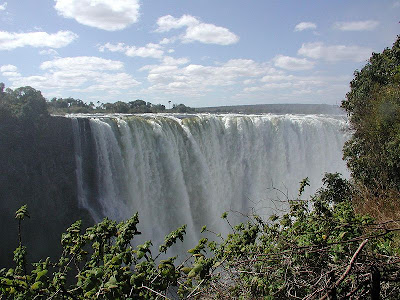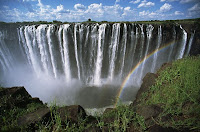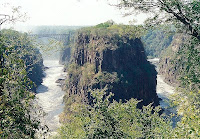The Victoria Falls or Mosi-oa-Tunya is one of the World heritage natural monument site. The Victoria Falls are some of the largest in the world. Mosi-oa-Tunya means the Smoke that Thunders. It is a waterfall located in southern Africa on the Zambezi River between the countries of Zambia and Zimbabwe. It The Victoria Falls are considered by some to be among the Seven Natural Wonders of the World. David Livingstone, the Scottish missionary and explorer, is believed to have been the first European recorded to view the Victoria Falls. While it is neither the highest nor the widest waterfall in the world, it is claimed to be the largest. This claim is based on a width of 1,708 metres or 5,604 ft and height of 108 meters or 360 ft, forming the largest sheet of falling water in the world.
 The Zambezi flows over a level sheet of basalt, in a shallow valley bounded by low and distant sandstone hills. The rivers course is dotted with numerous tree-covered islands, which increase in number as the river approaches the falls. There are no mountains, escarpments, or deep valleys which might be expected to create a waterfall, only flat plateau extending hundreds of kilometres in all directions.
The Zambezi flows over a level sheet of basalt, in a shallow valley bounded by low and distant sandstone hills. The rivers course is dotted with numerous tree-covered islands, which increase in number as the river approaches the falls. There are no mountains, escarpments, or deep valleys which might be expected to create a waterfall, only flat plateau extending hundreds of kilometres in all directions.The falls are formed as the full width of the river plummets in a single vertical drop into a transverse chasm 1708 meters or 5604 ft wide, carved by its waters along a fracture zone in the basalt plateau. The depth of the chasm, called the First Gorge, varies from 80 metres or 262 ft at its western end to 108 metres or 360 ft in the centre. The only outlet to the First Gorge is a 110-metre-wide or 360 ft gap about two-thirds of the way across the width of the falls from the western end, through which the whole volume of the river pours into the Victoria Falls gorges.
There are two islands on the crest of the falls that are large enough to divide the curtain of water even at full flood Boaruka Island or Cataract Island near the western bank and Livingstone Island near the middle. At less than full flood, additional islets divide the curtain of water into separate parallel streams. Victoria Falls is roughly thrice the height of North America Niagara Falls and well over twice the width of its Horseshoe Falls. In height and width Victoria Falls is rivalled only by South America Iguazu Falls.
The whole volume of the Zambezi River pours through the First Gorges 110-meter-wide or 360 ft exit for a distance of about 150 meters or 500 ft, then enters a zigzagging series of gorges designated by the order in which the river reaches them. Water entering the Second Gorge makes a sharp right turn and has carved out a deep pool there called the Boiling Pot. Reached via a steep footpath from the Zambian side, it is about 150 metres or 500 ft across. The walls of the gorges are nearly vertical and generally about 120 metres or 400 feet high, but the level of the river in them varies by up to 20 meters 65 feet between wet and dry seasons.
Nearly 300,000 people were visiting the falls annually, and this was expected to rise to over a million in the next decade. Unlike the game parks, Victoria Falls has more Zimbabwean and Zambian visitors than international tourists as they are accessible by bus and train and therefore comparatively inexpensive to reach. The two national parks at the falls are relatively small Mosi-oa-Tunya National Park is 66 square kilometres or 16,309 acres and Victoria Falls National Park is 23 square kilometres or 5,683 acres. However, next to the latter on the southern bank is the Zambezi National Park, extending 40 kilometers or 25 miles west along the river. Animals can move between the two Zimbabwean parks and can also reach Matetsi Safari Area, Kazuma Pan National Park and Hwange National Park to the south.
Mopane woodland savannah predominates in the area, with smaller areas of Miombo and Rhodesian Teak woodland and scrubland savannah. Riverine forest with palm trees lines the banks and islands above the falls. The most notable aspect of the area's vegetation though is the rainforest nurtured by the spray from the falls, containing plants rare for the area such as pod mahogany, ebony, ivory palm, wild date palm and a number of creepers and lianas. Vegetation has suffered in recent droughts, and so have the animals that depend on it, particularly antelope.

 The national parks contain abundant wildlife including sizable populations of elephant, buffalo, giraffe, zebra, and a variety of antelope. Lion and leopard are only occasionally seen. Vervet monkeys and baboons are common. The river above the falls contains large populations of hippopotamus and crocodile. Elephants cross the river in the dry season at particular crossing points.
The national parks contain abundant wildlife including sizable populations of elephant, buffalo, giraffe, zebra, and a variety of antelope. Lion and leopard are only occasionally seen. Vervet monkeys and baboons are common. The river above the falls contains large populations of hippopotamus and crocodile. Elephants cross the river in the dry season at particular crossing points.Klipspringers and clawless otters can be glimpsed in the gorges, but they are mainly known for 35 species of raptors. The Taita Falcon, Black Eagle, Peregrine Falcon and Augur Buzzard breed there. Above the falls, herons, Fish Eagles and numerous kinds of waterfowl are common. The river is home to 39 species of fish below the falls and 89 species above it, mostly black cod and slippery trout. This illustrates the effectiveness of the falls as a dividing barrier between the upper and lower Zambezi.
Post Title
→Victoria Falls
Post URL
→http://guidice-galleries.blogspot.com/2010/03/victoria-falls.html
Visit guidice galleries for Daily Updated Wedding Dresses Collection








